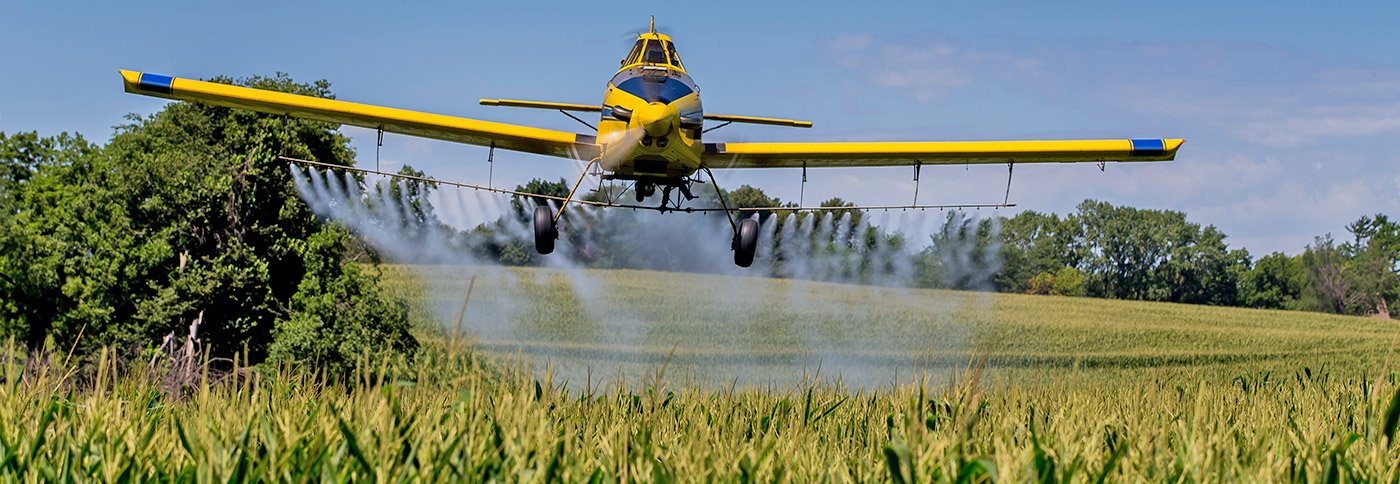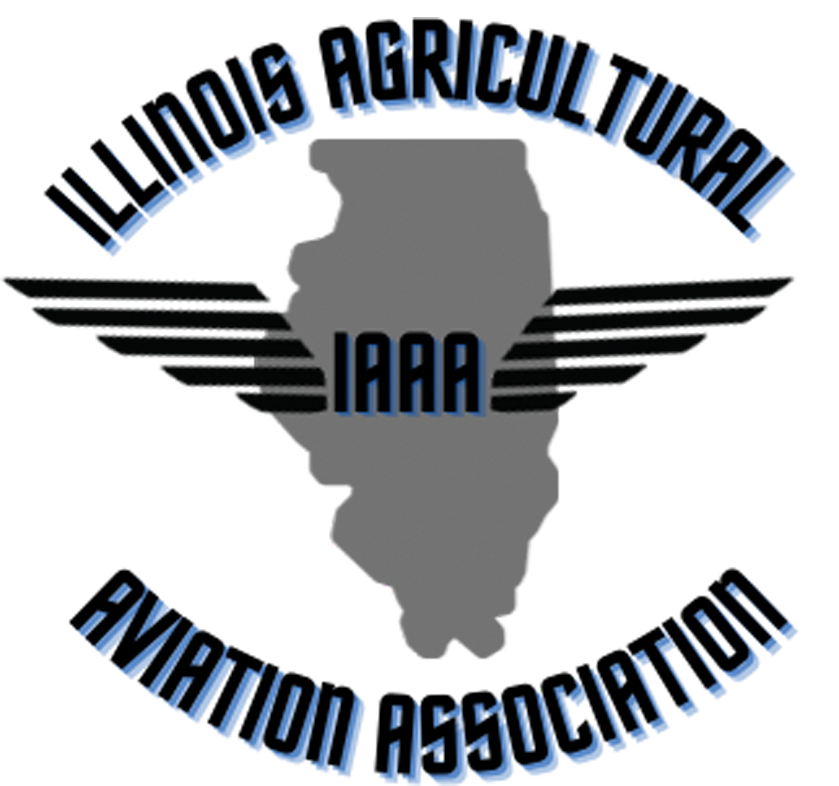
Sustainability
Serving Agriculture through Aviation
Illinois Agricultural Aviation Association
The members of the Illinois Agricultural Association are dedicated to providing the very best aerial application service possible, with an equal commitment to be conscientious stewards of our fragile environment. The purpose of the IAAA (Illinois Agricultural Aviation Association) shall be to coordinate and generally direct the efforts of the agricultural aviation industry on a state basis, at the state level, representing the entire industry and related interests, and the mutual benefits derived there from all its members.
Latest News

IAAA Upcoming Events 2025-2026
Calibration clinic will be held the 2nd week of June at Coles County Airport in Mattoon. Please be on the look out for more information and confirmed dates.
November 17, 2025 - November 19, 2025 2025 Ag Aviation Expo Atlantis & Reno Convention Center Reno, NV
December 9, 2025 - December 11, 2025 Mid States Ag Aviation Conference Isle of Capri Casino / Quad Cities Convention Center Bettendorf, IA
IAAA Members
Operator: Any firm or individual engaged in agricultural aviation. Operator members shall hold a valid FAA Part 137 Operating Certificate. These operator members shall have all rights and privileges including voting and holding office.
Pilot: Any pilot engaged in agricultural aviation. A pilot must be employed by an operator member in good standing. The pilot member shall have the right to vote and hold office.
Affiliated Operator: Any individual whether a business partner stockholder, or employee whose company is an Operator member described above. Affiliated operator members shall have the right to vote or hold office.
Allied Industry Company: Industrial organizations and firms not engaged in agricultural aviation, but closely allied to the agricultural aviation industry. The allied industry member does NOT have the right to vote or hold office.
Affiliated Allied Industry: An employee of a member of Allied Industry Company. The affiliated allied industry member does NOT have the right to vote or hold office
Associate Member: Any individual who does not qualify for any other membership categories but wishes to be associated with the IAAA. Any applicant for this category must be confirmed by the Treasurer and President. Associate Members do NOT have the right to vote or hold office.
FAQs
-
A: It is a somewhat outdated term used to describe either an aircraft used in agricultural aviation or the pilot who flies that aircraft. It is outdated because, although agricultural products were available only in a “dust” form over half a century ago, virtually all products are applied today as a liquid, which is sprayed. Yesterday’s crop dusters are today’s aerial applicators or ag pilots, but they all mean the same thing.
-
A: There are approximately 2400 companies in the U.S. certified by the FAA (Federal Aviation Administration). Both airplanes and helicopters are used in the industry, and there are about 5,000 aircraft with approximately that many trained pilots.
-
A: Almost everybody. Individual states regulate the pesticide application certification and certain loading and storage containment requirements. The federal agencies include FAA (Federal Aviation Administration), EPA (Environmental Protection Agency), USDA (United States Department of Agriculture), FDA Food and Drug Administration), OSHA (Occupational Safety and Health Administration), etc.
-
A: No, they are not. A helicopter creates a lot of downwash when it is hovering and that leads many to believe it provides more penetration into a crop canopy during application. As a helicopter moves from a hover to forward flight, that downwash is diminished. The rotors become similar to a flying “disk” and the result is no more downwash than is found coming from the wings of a fixed wing aircraft. The reality is that, all other conditions being equal, neither has the advantage in quality of application.
-
A: Virtually all ag aircraft are single seat aircraft, so hijacking is out of the question. A handful of ag aircraft have two seats and these are used for flight training and also for certain drug eradication programs in other countries.
-
A: Agricultural chemical products are regulated by the EPA (Environmental Protection Agency.) Years of testing go into every product before it is registered and legal to use in the U.S. Manufacture and distribution of the products is carried out in a manner similar to pharmaceutical drugs, with security and stringent controls at every level.
-
A: The aerial application industry in the U.S. is an integral part of American agriculture. Without these aircraft available as tools in food production, one third of Americans would go to bed hungry. Without crop dusters to treat cotton, yields would be substantially reduced and you would be forced to pay an exorbitant price for a simple cotton T-shirt. You may not even see agricultural aircraft in your part of the country, but you would surely be affected if they weren’t allowed to fly.
-
A: Check out these websites: www.agairupdate.com and www.agaviation.org
“ Our operator members are dedicated to providing the very best aerial application service possible, with an equal commitment to be conscientious stewards of our fragile environment. ”
Additional information
Our operator members are dedicated to providing the very best aerial application service possible, with an equal commitment to be conscientious stewards of our fragile environment.
Wind Farms
Wind power farms are being highly touted as a renewable energy source that is clean, safe and a responsible way to generate electricity for our nation. However, nothing comes without sacrifice and these projects are no exception. The issue is being complicated, either intentionally or otherwise, by not openly addressing the very real fact that farmers with wind generators may lose the option of aerial application of farm protection products, seeds, fertilizers, etc. on their farm grounds. Possibly more significant is that their neighbor farmers, who have no wind generator(s) and consequently no income from them, stand to lose that option as well.
Some proponents of wind farms tend to dismiss this possibility out of hand, with the explanation that “those guys can fly around them with no problem,” or “just get a helicopter to do it.” Others say that ground application can still be effectively performed so the aerial option is insignificant. Unfortunately, it is just not that simple. Sometimes weather problems and/or timeliness of application dictate an application from the air.
The fact is, it is dangerous to fly within the confines of a wind generator farm. Without going into the technical aspects, windmills can cause vertigo sensations, create unstable wind conditions, and extend high enough to seriously affect the way an aircraft can work a field. That is why even a neighboring field without a wind generator may not be a candidate for aerial application: there’s no room to make a turn.
Proponents of wind farms point out that the $4-5,000 paid each year to the landowner is a lot of money for a small piece of farm ground. Asian Rust has not been a factor thus far in Illinois, but the potential is huge. Match the $5,000 against a possible 80% yield loss of soybeans expected to average 60 bushels per acre. At $12/ bushel, that’s $576. If it’s an 80-acre field, that’s $46,080 lost. Cropping decisions will be tough in the future considering you can’t change your mind once the wind generator is up and operating.
Will a farmer find an aerial applicator willing to book a field in the vicinity of a wind power generator? The answer is “maybe.” It will most definitely be at an increased application cost; possibly double. Helicopters are not the answer because there are only a few working in the Midwest and they don’t like working in the wind farms either.
The Illinois Agricultural Aviation Association (IAAA) has been disappointed in the lack of candor by some wind generator proponents with regard to farmers’ potential loss of an aerial application option. We believe it is critical that a truthful picture be presented so that an informed decision can be reached. In June 2005, the following Resolution was passed by the IAAA Board of Directors. It was re-endorsed on March 10, 2009.
ILLINOIS AGRICULTURAL AVIATION ASSOCIATION RESOLUTION
WHEREAS, we acknowledge the need for affordable electric power and the efficient distribution of that power to the point of its consumption, and
WHEREAS, we acknowledge the environmental benefits of wind-generated electrical power, and
WHEREAS, we understand the financial considerations involved when decisions are made to place wind turbines on otherwise productive farm grounds, and
WHEREAS, wind turbine generator farms create uniquely hazardous and unacceptable dangers to pilots flying agricultural aircraft in a ground environment,
WE HEREBY RESOLVE that, in the interest of pilot safety, we will refuse to make an aerial application of any product inside a grouping of wind generators, or to farmland immediately adjacent to a grouping of wind generators, should that proximity be considered hazardous by the pilot of the agricultural aircraft.
Approved by unanimous vote of the Board of Directors of the Illinois Agricultural Aviation Association.
For more information about the Illinois Agricultural Aviation Association, please fill out the form below
Mailing Address:
1276 Hwy 94
Aledo, IL 61231

Interested in Joining IAAA?
Send us your information here
Thank you for your interest in joining our association. Please complete and submit this form, along with the appropriate dues amount, to
IAAA, 1276 Highway 94, Aledo, IL 61231.
Questions? Call: 309-582-5445 or Email: lindellg@diversifiedapps.com





